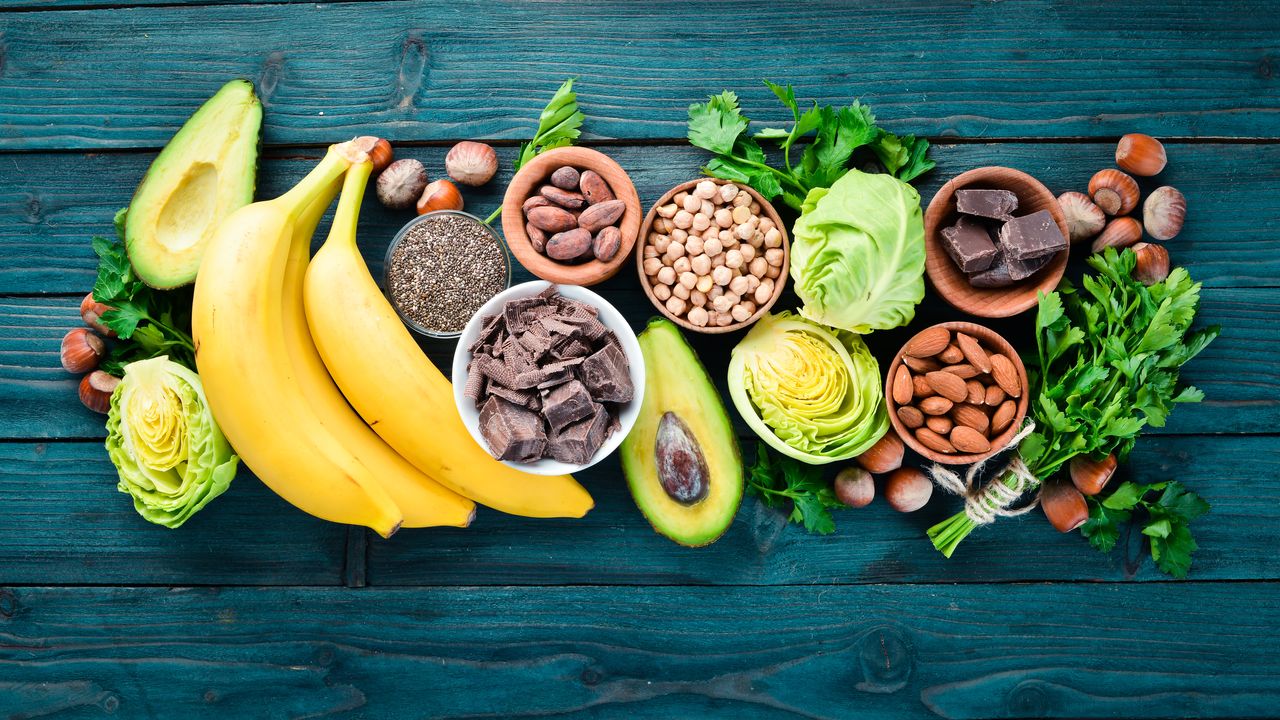[ad_1]
Magnesium is an important micronutrient that is essential for numerous body functions. This nutrient is imperative for healthy bones, calcium absorption, metabolism of food, synthesis of fatty acids and proteins, as well as nerve function. Magnesium deficiency presents in many ways that can easily be overlooked. Muscle cramps, fatigue, arrhythmia, dizziness, nausea, numbness, insomnia, brain fog, and anxiety are just a few of the symptoms that magnesium wards against. Causes of deficiency can include eating the wrong foods, excessive alcohol consumption, some prescription medications, high-sugar diets, over-use of acid inhibitors, and leaky gut syndrome. All of these things can contribute to insufficient magnesium in the body and thus it is important to include magnesium rich food sin your diet.
According to research, magnesium is responsible for 300 biochemical processes in the body. One way to avoid magnesium deficiency is to ensure that you are getting enough magnesium rich foods! Below is a list of 10 common foods that you can incorporate into your diet throughout the day for not just magnesium, but all the other nutrients that magnesium works together with to be used and properly absorbed into the body.
Foods Rich in Magnesium
1. Nuts
Cashews, Brazil nuts, and almonds are very rich in magnesium. Cashews contribute 82 mg in a one-ounce serving or 20% of the recommended daily intake (RDI). They are also a great source for selenium, fiber, and monounsaturated fats, all of which help to regulate blood sugar and cholesterol levels. Nuts are anti-inflammatory and can help to improve heart health. In the evening they are a great snack to help keep glucose levels from dropping too low interrupting sleep. However, be careful not to eat too many nuts, as they are high in fat. A recommended serving would be 2 oz of nuts 1-2 times a day.
2. Legumes
Legumes like lentils, black beans, chickpeas, peas, and soybeans are known to be a great source of protein. However, they are also very high in magnesium. One cup of black beans brings 120 mg of magnesium or fulfills 30% of the RDI in your diet. Other micronutrients they include are potassium and iron, as well as an essential protein and fiber source for plant-based diets. Legumes are a great fighter against one of the major global issues, Heart Disease.
3. Fatty Fish
Wild caught salmon, mackerel, and halibut are all fish that are high in magnesium. 180 grams of salmon offers 13% of the RDI of magnesium. Omega-3 fatty acids are also important contents of salmon which help to fight heart disease. In 180 grams of salmon, there is 39 grams of protein, B vitamins, selenium, and potassium which complement magnesium for a healthy heart and brain.
4. Organic Tofu
Tofu is high in protein and magnesium. It is made of soybean milk that is pressed into small white curds. Selecting organic tofu is important with soy crops as they are the longest growing crop, hence heavily treated with pesticide. Soy is a great source of protein and magnesium, especially for the plant-based diet. A 3.5-ounce serving has 13% RDI or 53 mg of magnesium. Other micronutrients in tofu include calcium, iron, selenium, and manganese.
5. Chocolate
Dark chocolate cravings? Magnesium may be one of the things that can help. A small dark chocolate bar provides 226 mg of magnesium per 100 grams. It also contains nutrients like iron, antioxidants, manganese, copper, and prebiotic fiber. However, moderation is the key. Due to high sugar content in store bought chocolates, it is only good to consume little everyday.Small portions of dark chocolate can be great for the heart and gut health. It is best to consume dark chocolates which contain 70% and more of cocoa.
6. Seeds
Chia, pumpkin and flax are some of the fortified foods with magnesium. Pumpkin seeds contain 150 mg of magnesium in a one-ounce serving, which is 40-50% RDI. One tablespoon of flax or chia seeds contain approximately 40 mg of magnesium or 15% RDI with iron, antioxidants, fiber, and monounsaturated fats as well. These seeds are also packed with omega-3 fatty acids which promotes a healthy brain and heart. If you want to improve cognitive function add some ground flax to your oatmeal, smoothies, salads, soups and sauces. You can also make a trail mix containing seeds, nuts, your favorite dry berries and granola that can be a perfect snack for munching.
7. Avocados
Avocados can be used in various ways in your diet. Whether you are adding slices to a salad, blending them into a smoothie, or making guacamole, you can expect 58 mg or 15% RDI of magnesium from this fruit. Vitamins K, B, potassium, monounsaturated fats and fiber are working together in this fruit to make it one of the most powerful elements in the nutrition world. Also, avocados help improve cholesterol, reduce inflammation, and increase feelings of fullness, which encourage weight loss!
8. Bananas
This fruit is one of the most common fruits in a household. Although bananas are known for high potassium content, they also source about 37 mg of magnesium. Other nutrients it packs are fiber, vitamin B6, and vitamin C. It is recommended to consume bananas that are slightly less mature than its ripened alternatives. The starch of the younger bananas remain intact, when consumed. It passes to the large intestine where it’s broken down by the gut bacteria. Interestingly, this also makes for a wonderful prebiotic to help improve gut health. In addition, ripe bananas are also higher in carbohydrates and sugar.
9. Organic Leafy Greens
Another crop that is imperative to shop organic is the dark leafy green family. Things in nature love to eat these greens just as much as we do. These crops, if not organically grown, are heavily treated with chemicals to prevent this. This happens especially in the case of root vegetables, which absorb multiple seasons of treatment from the soil. Leafy greens are a popular manganese rich food, full of other great vitamins such as A, C, and K. One cup of cooked spinach comprises around 40% of the RDI of magnesium . Mustard greens, kale, turnip greens and many more of this family all help to oxidize and detoxify cells, thus promoting cancer prevention. Adding a handful of spinach to any fruit smoothie can be a nice trick when trying to sneak those greens into your children’s diet!
10. Oysters
Oysters provide 37 mg of magnesium or 9% DV in just 3 oz. Magnesium yes, but oysters are more famous for their amazing zinc and copper content at over 188% DV of zinc and 114% DV of copper! Like fish, they also provide omega-3 fatty acids, protein, and vitamin D. These micronutrients provide building blocks for very important processes in the body like DNA synthesis, bone and tissue repair, cognitive function, and anti-inflammatories for disease prevention.
The Bottom Line
Altogether, magnesium is a huge building block that the body needs to operate properly. As magnesium contributes to 300 biochemical processes in the body, it is vital to incorporate these magnesium- rich foods into your daily routines. If you are looking to improve your brain function, sleep, and daily energy, rotate these foods into each meal and enjoy some variety while improving your overall health and wellness.
[ad_2]
Source link


